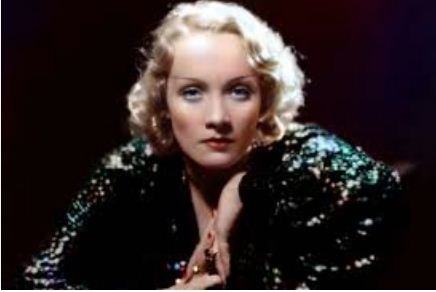Who is Marlene Dietrich?
Marlene Dietrich, born Maria Magdalene Dietrich on December 27, 1901, in Berlin, Germany, emerged as one of the most iconic figures in the entertainment industry during the early to mid-20th century. She achieved her peak fame during the 1930s and 1940s, a pivotal time when her extraordinary talent captivated audiences around the world. Dietrich was not only an actress but also a renowned singer, known for her distinctive contralto voice, which further elevated her status in show business.
Her early life played a significant role in shaping her artistic persona. Born to a middle-class family, with her father serving as a Prussian police officer and her mother a talented violinist, Dietrich’s upbringing was steeped in music and culture. She took up violin lessons and developed a passion for performance at a young age, which laid the foundation for her future career. It was during her teenage years that she began to explore the world of theater and film, eventually transitioning to the silent film era, which was gaining momentum in Germany.
Dietrich found her breakthrough role in the 1930 film “The Blue Angel,” where she portrayed the seductress Lola-Lola, a performance that garnered both critical acclaim and public fascination. This role catapulted her to international stardom, leading her to Hollywood, where she starred in a series of successful films, including “Morocco” and “Shanghai Express.” Her ability to embody multifaceted characters, coupled with her enchanting looks and enigmatic presence, allowed her to transcend the traditional boundaries of gender roles in cinema. Through her compelling performances and unique style, Marlene Dietrich cemented her place as a formidable figure in entertainment history, influencing countless artists and leaving a lasting legacy that endures to this day.
Marlene Dietrich’s Hometown
Marlene Dietrich was born on December 27, 1901, in the vibrant city of Berlin, Germany. Known for its dynamic cultural landscape, Berlin during the early 20th century was a bustling metropolis that was rich in artistic expressions, architecture, and progressive movements. This environment profoundly shaped Dietrich’s upbringing, impacting her career choices and artistic expression.
Raised in a city that was at the forefront of artistic movements, Dietrich was exposed to a blend of theatrical performances, operas, and visual arts from a young age. The influence of Weimar Berlin, marked by its experimentation in music and film, created fertile ground for her burgeoning talent. Berlin’s nightlife, epitomized by cabarets and theaters, showcased a range of performances that celebrated diversity and individualism—values that resonated deeply with Dietrich and would later inform her own distinctive style and artistic voice.
The city’s cultural scene offered Dietrich not only inspiration but also opportunities for her to hone her craft. Initially studying at the Royal Academy of Arts, she eventually found her calling in theater and film, participating in various productions that emphasized the avant-garde spirit of the time. The societal revolution that Berlin experienced during the Weimar Republic—characterized by newfound liberties in gender roles and sexual identity—allowed Dietrich to explore and express her own complex persona on stage and in front of the camera.
The influences from Berlin undeniably set the stage for Marlene Dietrich’s illustrious career. Her hometown’s blend of artistic innovation and cultural richness helped cultivate a performer who would later become a symbol of glamour and intrigue in Hollywood. This background not only laid the foundation for her success but also contributed to her enduring legacy as an icon of the silver screen.
Physical Characteristics: Height and Presence
Marlene Dietrich’s physical stature significantly contributed to her iconic status in Hollywood. Standing at approximately 5 feet 5 inches tall, her height was complemented by an elegant and slender frame. This combination allowed her to embody both femininity and an air of commanding presence, captivating audiences on-screen and at public appearances alike. Dietrich’s distinctive look transformed her into a muse for many designers and photographers, elevating her image to an unattainable ideal, and setting trends that would resonate throughout the decades.
One of the most notable aspects of Marlene Dietrich’s physical characteristics was her ability to blend various elements of traditional beauty with a more androgynous appeal. Her striking bone structure, characterized by high cheekbones and a strong jawline, allowed her to wear both men’s and women’s clothing with equal confidence. This unique juxtaposition created a memorable visual aesthetic that played a pivotal role in her film performances, making her a favorite among those who appreciated unconventional femininity.
Moreover, Dietrich’s ethereal and enigmatic qualities were accentuated by her carefully crafted persona, which included her signature platinum blonde hair and sultry gaze. She often utilized makeup and costuming to enhance her presence, creating a visual spectacle that resonated with audiences. This deliberate construction of identity not only solidified her status as a style icon but also allowed her to challenge gender norms prevalent during her time. As she graced the screens of the early 20th century, her magnetic presence and unique aesthetics cemented her legacy as an indelible figure in film history, making her performances unforgettable.
Famous Movies Featuring Marlene Dietrich
Marlene Dietrich, an iconic figure in the world of cinema, graced the silver screen with her captivating performances in numerous films that showcased her extraordinary talent. Among her most notable works is “The Blue Angel” (1930), directed by Josef von Sternberg. This film marked Dietrich’s breakthrough role and is widely regarded as a classic of German cinema. Playing the role of Lola Lola, she mesmerized audiences with her sultry presence, which helped to solidify her status as a leading actress in Europe.
Dietrich’s collaboration with director Josef von Sternberg continued with “Dishonored” (1931), where she portrayed a captivating spy during World War I. Her performance not only emphasized her versatility as an actress but also featured one of the most memorable scenes of her wearing a soldier’s uniform, subverting traditional gender roles in cinema. This role reinforced Dietrich’s image as a glamorous and powerful female figure on screen.
In 1939, Dietrich starred in “Desire,” alongside Gary Cooper. This romantic drama allowed her to showcase her ability to blend vulnerability with strength, further expanding her repertoire. As her career progressed, Dietrich transitioned to Hollywood, where she starred in films like “The Scarlet Empress” (1934) and “Shanghai Express” (1932). The latter film received critical acclaim and established her as a significant cinematic personality, known for her enigmatic portrayals and alluring presence.
Furthermore, her appearance in “Witness for the Prosecution” (1957) demonstrated her enduring talent, earning her an Academy Award nomination. Dietrich’s contributions to the film industry have been profound, with her works reflecting the evolution of modern cinema while cementing her legacy as one of Hollywood’s most enduring stars.
Marlene Dietrich’s Personal Life and Current Relationship
Marlene Dietrich, a Hollywood icon renowned for her magnetic presence on screen, lived a personal life as compelling as her cinematic roles. Born in Berlin in 1901, Dietrich’s early years were shaped by her upbringing in a musical family, which initially influenced her passion for performing. However, her romantic relationships later became a significant aspect of her life narrative, revealing the complexities of her character beyond her glamorous public persona.
Dietrich’s romantic interests were diverse, and her relationships often crossed traditional boundaries. Notably, she had a long-standing affair with French actor Jean Gabin, which showcased her attraction to both men and women. Her partnership with the writer and poet Ernest Hemingway reflected a deep intellectual bond, with their mutual respect evident throughout their encounters. Moreover, her friendships with prominent figures like Greta Garbo and actress Mabel Normand hinted at the fluidity of her affections. Despite the notable affairs, Dietrich chose to keep much of her romantic life private. Her ability to navigate these relationships, often without conforming to societal norms, illustrated her progressive views on love and companionship.
Awards and Honors: Recognizing Marlene’s Talent
Marlene Dietrich, an emblematic figure in the entertainment industry, garnered numerous accolades throughout her illustrious career, reflecting her profound impact on film and music. Her talent was recognized through various prestigious awards, beginning with her breakthrough role in the 1930 film “The Blue Angel,” which earned her international acclaim. This performance not only established her as a leading actress but also marked the beginning of a new era in cinema, where she combined provocative performances with a distinct on-screen presence.
In the realm of film, Dietrich’s contributions were acknowledged with several Academy Award nominations, a testament to her ability to transcend the limitations of her roles. Although she never won a competitive Oscar, she was awarded an honorary Academy Award in 1999, which celebrated her extraordinary talents and contributions to the cinematic world. This recognition served as a significant acknowledgment of her status and influence, not just in American cinema, but globally.
Additionally, Dietrich was honored with the unique “Fifth Avenue Walk of Fame” star in 1960, further solidifying her legacy. Recognizing her unique ability to introduce cabaret-style performances to a broader audience, she was awarded numerous accolades in music as well. Her recordings spun to the top of the charts, garnering her a Grammy Lifetime Achievement Award posthumously in 1993, showing how the music world valued her performing prowess.
Dietrich’s achievements also extend to her humanitarian efforts, as she was awarded the Medal of Freedom for her contributions during World War II, exemplifying her commitment not only to performance but also to her principles. Overall, the multitude of awards and honors that Marlene Dietrich received throughout her lifetime underscores her undeniable influence on the arts and her timeless legacy as a performer.
Marlene Dietrich’s Influence on Modern Cinema
Marlene Dietrich’s impact on the film industry extends far beyond her era, leaving an indelible mark on contemporary cinema. Renowned for her captivating performances and innovative style, Dietrich redefined the standards of female representation in film during a time when women were primarily confined to traditional roles. She effortlessly blended femininity with elements of androgyny, challenging conventional notions of gender. This bold choice resonated with audiences and has inspired countless actresses to embrace their individuality and defy stereotypes.
Dietrich’s unique on-screen presence served as a catalyst for a wave of change, influencing future generations of filmmakers and performers. Her ability to convey complex emotions through subtle expressions allowed her to forge a connection with the audience, an attribute that remains highly sought after in modern actors. Additionally, her savvy sense of fashion and striking visual aesthetic continue to serve as inspiration in contemporary film. Directors often draw upon her iconic looks and stylistic choices to evoke a sense of nostalgia while exploring themes related to identity and liberation.
Moreover, Dietrich’s contributions to gender representation have been profound. By actively taking on roles that challenged societal norms, she paved the way for a more nuanced exploration of female characters in the cinematic landscape. This has led to the emergence of multifaceted portrayals of women that reflect the complexities of real life. As filmmakers and writers today embrace diverse narratives, Dietrich’s legacy as a trailblazer for gender equality in film remains highly relevant.
In essence, Marlene Dietrich’s influence on modern cinema is a testament to her groundbreaking artistic choices. Her work not only redefined women’s roles in the industry but also created a lasting legacy that continues to inspire. As new generations of artists seek to push boundaries, Dietrich’s daring spirit serves as a guiding light for those striving to change the cinematic narrative.
Legacy and Cultural Impact
Marlene Dietrich is often regarded as one of the most influential figures in the entertainment industry, transcending both film and fashion to leave an indelible mark on popular culture. Her unique style, characterized by a blend of androgyny and glamor, established new norms in fashion. Dietrich’s bold choice to don tuxedos and adopt a nonchalant demeanor in a male-dominated industry challenged traditional gender roles. This understated rebellion has had lasting implications for fashion, as it paved the way for subsequent generations of women to express their individuality through their attire.
Moreover, her impact extends beyond the realm of fashion to include music, where her sultry voice and captivating stage presence resonated with audiences worldwide. Songs such as “Falling in Love Again” not only showcased her vocal talent but also reinforced her iconic status as a performer. Throughout her career, Dietrich successfully blended music and visual artistry, influencing the cabaret genre and inspiring countless artists who admired her unique blend of femininity and strength.
Dietrich also played an essential role in the feminist movements of the 20th century. Her unflinching embrace of her sexuality, along with her defiance of conventional norms, empowered women to break free from societal constraints. By living authentically and challenging stereotypes, she became a symbol of liberation and independence for many. This cultural impact solidified her status as an icon not just in Hollywood but also in feminist discourse. As her legacy endures, contemporary discussions around gender fluidity and empowerment continue to draw inspiration from her life and artistry.
In conclusion, Marlene Dietrich’s multifaceted legacy transcends her performances, as she remains a powerful cultural symbol, influencing fashion, music, and feminist ideologies to this day.
Conclusion: The Enduring Icon of Marlene Dietrich
Marlene Dietrich’s life and career represent a fascinating narrative of talent, resilience, and charisma. Born in Berlin in 1901, she swiftly captivated audiences with her unique blend of beauty and talent, transitioning from the theatrical world to Hollywood stardom. Her role in the 1930 film “The Blue Angel” marked the watershed moment that launched her career in America, demonstrating her extraordinary ability to melt into various roles while retaining an unmistakable presence.
Dietrich’s contributions to the arts extend beyond her performances. Her unapologetic embrace of individuality and gender fluidity reshaped conventional notions of femininity during a time when societal expectations were rigid. Through her roles and public persona, she advocated for women’s liberation and challenged the status quo, making her a symbol of empowerment for future generations. Dietrich’s music career, enriched by her sultry voice and impeccable phrasing, further solidified her status as an influential artist who could transcend mediums.
Moreover, her courageous stand against fascism during World War II showcased her deep conviction and commitment to humanitarian values. By entertaining troops and advocating for freedom, she intertwined her stardom with activism, leaving an indelible mark on history. Her willingness to stand up for her beliefs resonates to this day, reminding us that art can be a formidable weapon against oppression.
In conclusion, Marlene Dietrich remains an enduring icon whose legacy continues to inspire artists and audiences alike. Her remarkable journey stands as a testament to the power of authenticity, creativity, and courage. As we reflect on her contributions, we not only celebrate her unparalleled career but also embrace the lessons of perseverance and self-expression she exemplified throughout her life.



